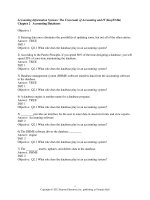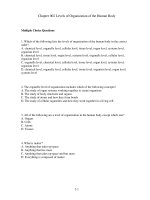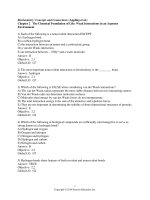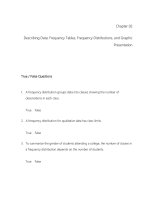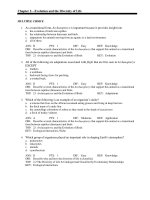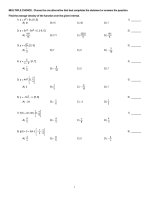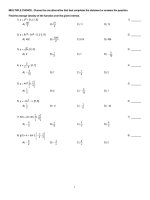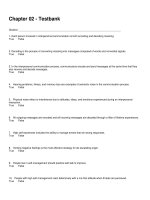Calculus for scientists and engineers 1st edition briggs test bank
Bạn đang xem bản rút gọn của tài liệu. Xem và tải ngay bản đầy đủ của tài liệu tại đây (836.61 KB, 59 trang )
MULTIPLE CHOICE. Choose the one alternative that best completes the statement or answers the question.
Find the average velocity of the function over the given interval.
1) y = x2 + 6x, [6, 9]
A) 21
2) y = 3x3 - 8x2 + 6, [-8, 5]
181
A)
13
1)
B) 15
C) 45
D) 7
B) 171
2223
C)
5
181
D)
5
C) 2
3
D) 10
2)
3) y =
2x, [2, 8]
1
A)
3
4) y =
3)
B) 7
3
, [4, 7]
x-2
A)
4)
1
3
5) y = 4x2 , 0,
B) -
3
10
C) 2
D) 7
7
4
5)
A) 2
B)
1
3
C) -
3
10
D) 7
6) y = -3x2 - x, [5, 6]
A) -34
7) h(t) = sin (4t), 0,
A)
A)
B) -
4
π
1
6
C) -2
D)
1
2
π
8
8
π
8) g(t) = 3 + tan t, -
6)
7)
B) -
8
π
C)
π
8
D)
4
π
π π
,
4 4
8)
B) -
8
5
C) 0
1
D) -
4
π
Use the table to find the instantaneous velocity of y at the specified value of x.
9) x = 1.
x y
0 0
0.2 0.02
0.4 0.08
0.6 0.18
0.8 0.32
1.0 0.5
1.2 0.72
1.4 0.98
A) 2
B) 0.5
C) 1
9)
D) 1.5
10) x = 1.
x y
0 0
0.2 0.01
0.4 0.04
0.6 0.09
0.8 0.16
1.0 0.25
1.2 0.36
1.4 0.49
A) 1
10)
B) 0.5
C) 1.5
D) 2
11) x = 1.
x y
0 0
0.2 0.12
0.4 0.48
0.6 1.08
0.8 1.92
1.0 3
1.2 4.32
1.4 5.88
A) 4
11)
B) 2
C) 6
2
D) 8
12) x = 2.
x y
0 10
0.5 38
1.0 58
1.5 70
2.0 74
2.5 70
3.0 58
3.5 38
4.0 10
A) 4
12)
B) 8
C) 0
D) -8
13) x = 1.
x
y
0.900 -0.05263
0.990 -0.00503
0.999 -0.0005
1.000 0.0000
1.001 0.0005
1.010 0.00498
1.100 0.04762
A) 0
13)
B) -0.5
C) 1
D) 0.5
C) slope is -39
1
D) slope is
20
Find the slope of the curve for the given value of x.
14) y = x2 + 5x, x = 4
4
A) slope is 25
15) y = x2 + 11x - 15, x = 1
4
A) slope is 25
16) y = x3 - 5x, x = 1
A) slope is -3
14)
B) slope is 13
15)
1
B) slope is
20
C) slope is 13
D) slope is -39
16)
B) slope is 1
C) slope is 3
D) slope is -2
17) y = x3 - 3x2 + 4, x = 1
A) slope is 0
B) slope is --3
C) slope is -3
D) slope is 1
18) y = 2 - x3 , x = 1
A) slope is 0
B) slope is -3
C) slope is -1
D) slope is 3
17)
18)
3
Solve the problem.
19) Given lim f(x) = Ll, lim f(x) = Lr, and Ll ≠ Lr, which of the following statements is true?
x→0 x→0 +
I.
lim f(x) = Ll
x→0
II.
lim f(x) = Lr
x→0
19)
III. lim f(x) does not exist.
x→0
A) I
20) Given
B) none
C) II
D) III
lim f(x) = Ll, lim f(x) = Lr , and Ll = Lr, which of the following statements is false?
x→0 x→0 +
I.
lim f(x) = Ll
x→0
II.
lim f(x) = Lr
x→0
20)
III. lim f(x) does not exist.
x→0
A) I
B) II
C) III
D) none
21) If lim f(x) = L, which of the following expressions are true?
x→0
I.
lim f(x) does not exist.
x→0 -
II.
lim f(x) does not exist.
x→0 +
III.
lim f(x) = L
x→0 -
IV.
lim f(x) = L
x→0 +
A) II and III only
B) III and IV only
C) I and II only
21)
D) I and IV only
22) What conditions, when present, are sufficient to conclude that a function f(x) has a limit as x
approaches some value of a?
A) Either the limit of f(x) as x→a from the left exists or the limit of f(x) as x→a from the right
exists
B) The limit of f(x) as x→a from the left exists, the limit of f(x) as x→a from the right exists, and
at least one of these limits is the same as f(a).
C) f(a) exists, the limit of f(x) as x→a from the left exists, and the limit of f(x) as x→a from the
right exists.
D) The limit of f(x) as x→a from the left exists, the limit of f(x) as x→a from the right exists, and
these two limits are the same.
4
22)
Use the graph to evaluate the limit.
23) lim f(x)
x→-1
23)
y
1
-6 -5 -4 -3 -2 -1
1
2
3
4
5
B) -
3
4
6 x
-1
A) -1
C) ∞
D)
3
4
24) lim f(x)
x→0
24)
y
4
3
2
1
-4
-3
-2
-1
1
2
3
4 x
-1
-2
-3
-4
A) does not exist
C) -3
B) 3
5
D) 0
25) lim f(x)
x→0
25)
6
y
5
4
3
2
1
-6 -5 -4 -3 -2 -1
-1
1
2
3
4
5
6 x
-2
-3
-4
-5
-6
A) does not exist
B) 3
C) 0
D) -3
26) lim f(x)
x→0
26)
12
y
10
8
6
4
2
-2
-1
1
2
3
4
5
x
-2
-4
A) does not exist
C) -1
B) 0
6
D) 6
27) lim f(x)
x→0
27)
y
4
3
2
1
-4
-3
-2
-1
1
2
3
4 x
-1
-2
-3
-4
A) 1
C) -1
B) does not exist
D) ∞
28) lim f(x)
x→0
28)
y
4
3
2
1
-4
-3
-2
-1
1
2
3
4 x
-1
-2
-3
-4
A) does not exist
B) -1
C) ∞
7
D) 1
29) lim f(x)
x→0
29)
y
4
3
2
1
-4
-3
-2
-1
1
2
3
4
x
-1
-2
-3
-4
A) 2
B) 0
C) does not exist
D) -2
30) lim f(x)
x→0
30)
y
4
3
2
1
-4
-3
-2
-1
1
2
3
4
x
-1
-2
-3
-4
A) 0
B) does not exist
C) 1
8
D) -2
31) lim f(x)
x→0
31)
y
4
3
2
1
-4
-3
-2
-1
1
2
3
x
4
-1
-2
-3
-4
A) -2
32) Find
B) does not exist
C) 2
D) -1
lim f(x) and
lim
f(x)
x→(-1)x→(-1)+
32)
y
2
-4
-2
2
4
x
-2
-4
-6
A) -7; -2
B) -2; -7
C) -7; -5
9
D) -5; -2
Use the table of values of f to estimate the limit.
33) Let f(x) = x2 + 8x - 2, find lim f(x).
x→2
x
f(x)
1.9
1.99
1.999
33)
2.001
2.01
2.1
A)
x 1.9
1.99 1.999 2.001 2.01 2.1
; limit = ∞
f(x) 5.043 5.364 5.396 5.404 5.436 5.763
B)
x 1.9
1.99 1.999 2.001 2.01 2.1
; limit = 5.40
f(x) 5.043 5.364 5.396 5.404 5.436 5.763
C)
x
1.9
1.99
1.999 2.001 2.01
2.1
; limit = 18.0
f(x) 16.810 17.880 17.988 18.012 18.120 19.210
D)
x
1.9
1.99
1.999 2.001 2.01
2.1
; limit = 17.70
f(x) 16.692 17.592 17.689 17.710 17.808 18.789
34) Let f(x) =
x
f(x)
x-4
, find lim f(x).
x-2
x→4
3.9
3.99
3.999
34)
4.001
4.01
4.1
A)
x 3.9
3.99
3.999
4.001
4.01
4.1
; limit = 5.10
f(x) 5.07736 5.09775 5.09978 5.10022 5.10225 5.12236
B)
x 3.9
3.99
3.999
4.001
4.01
4.1
; limit = 1.20
f(x) 1.19245 1.19925 1.19993 1.20007 1.20075 1.20745
C)
x 3.9
3.99
3.999
4.001
4.01
4.1
; limit = 4.0
f(x) 3.97484 3.99750 3.99975 4.00025 4.00250 4.02485
D)
x 3.9
3.99
3.999
4.001
4.01
4.1
; limit = ∞
f(x) 1.19245 1.19925 1.19993 1.20007 1.20075 1.20745
10
35) Let f(x) = x2 - 5, find lim f(x).
x→0
-0.1
x
f(x)
-0.01
35)
-0.001
0.001
0.01
0.1
A)
x -0.1
f(x) -1.4970
-0.01
-1.4999
-0.001
-1.5000
0.001
0.01
0.1
; limit = -15.0
-1.5000 -1.4999 -1.4970
x -0.1
f(x) -1.4970
-0.01
-1.4999
-0.001
-1.5000
0.001
0.01
0.1
; limit = ∞
-1.5000 -1.4999 -1.4970
x -0.1
f(x) -2.9910
-0.01
-2.9999
-0.001
-3.0000
0.001
0.01
0.1
; limit = -3.0
-3.0000 -2.9999 -2.9910
x -0.1
f(x) -4.9900
-0.01
-4.9999
-0.001
-5.0000
0.001
0.01
0.1
; limit = -5.0
-5.0000 -4.9999 -4.9900
B)
C)
D)
36) Let f(x) =
x
f(x)
x-3
x2 + 2x - 15
, find lim f(x).
x→3
2.9
2.99
2.999
36)
3.001
3.01
3.1
A)
x
2.9
2.99
2.999 3.001
3.01
3.1 ; limit = 0.125
f(x) 0.1266 0.1252 0.1250 0.1250 0.1248 0.1235
B)
x
2.9
2.99
2.999
3.001
3.01
3.1
; limit = -0.125
f(x) -0.1266 -0.1252 -0.1250 -0.1250 -0.1248 -0.1235
C)
x
2.9
2.99
2.999 3.001
3.01
3.1 ; limit = 0.025
f(x) 0.0266 0.0252 0.0250 0.0250 0.0248 0.0235
D)
x
2.9
2.99
2.999 3.001
3.01
3.1 ; limit = 0.225
f(x) 0.2266 0.2252 0.2250 0.2250 0.2248 0.2235
11
37) Let f(x) =
x
f(x)
x2 - 5x + 4
, find lim f(x).
x2 - 6x + 5
x→1
0.9
0.99
37)
0.999
1.001
1.01
1.1
A)
x
0.9
0.99
0.999 1.001
1.01
1.1 ; limit = 0.75
f(x) 0.7561 0.7506 0.7501 0.7499 0.7494 0.7436
B)
x
0.9
0.99
0.999 1.001
1.01
1.1 ; limit = 0.65
f(x) 0.6561 0.6506 0.6501 0.6499 0.6494 0.6436
C)
x
0.9
0.99
0.999 1.001
1.01
1.1 ; limit = 0.8333
f(x) 0.8361 0.8336 0.8334 0.8333 0.8331 0.8305
D)
x
0.9
0.99
0.999 1.001
1.01
1.1 ; limit = 0.85
f(x) 0.8561 0.8506 0.8501 0.8499 0.8494 0.8436
38) Let f(x) =
x
f(x)
sin(6x)
, find lim f(x).
x
x→0
-0.1
-0.01
5.99640065
-0.001
38)
0.001
0.01
5.99640065
A) limit = 6
C) limit = 5.5
39) Let f(θ) =
0.1
B) limit does not exist
D) limit = 0
cos (6θ)
, find lim f(θ).
θ
θ→0
x
-0.1
f(θ) -8.2533561
-0.01
-0.001
39)
0.001
0.01
0.1
8.2533561
B) limit = 6
D) limit = 8.2533561
A) limit does not exist
C) limit = 0
SHORT ANSWER. Write the word or phrase that best completes each statement or answers the question.
Provide an appropriate response.
40) It can be shown that the inequalities 1 -
x2
x sin(x)
<
< 1 hold for all values of x close
6
2 - 2 cos(x)
to zero. What, if anything, does this tell you about
x sin(x)
? Explain.
2 - 2 cos(x)
12
40)
MULTIPLE CHOICE. Choose the one alternative that best completes the statement or answers the question.
41) Write the formal notation for the principle "the limit of a quotient is the quotient of the limits" and
include a statement of any restrictions on the principle.
lim g(x)
x→a
g(x)
M
A) If lim g(x) = M and lim f(x) = L, then lim
=
= , provided that
f(x)
lim
f(x)
L
x→a
x→a
x→a
x→a
41)
f(a) ≠ 0.
lim g(x)
x→a
g(x)
M
B) If lim g(x) = M and lim f(x) = L, then lim
=
= , provided that
lim f(x)
L
x→a
x→a
x→a f(x)
x→a
L ≠ 0.
g(x) g(a)
C) lim
.
=
f(a)
x→a f(x)
g(x) g(a)
D) lim
, provided that f(a) ≠ 0.
=
f(a)
x→a f(x)
42) Provide a short sentence that summarizes the general limit principle given by the formal notation
lim [f(x) ± g(x)] = lim f(x) ± lim g(x) = L ± M, given that lim f(x) = L and lim g(x) = M.
x→a
x→a
x→a
x→a
x→a
42)
A) The sum or the difference of two functions is the sum of two limits.
B) The limit of a sum or a difference is the sum or the difference of the functions.
C) The limit of a sum or a difference is the sum or the difference of the limits.
D) The sum or the difference of two functions is continuous.
43) The statement "the limit of a constant times a function is the constant times the limit" follows from
a combination of two fundamental limit principles. What are they?
A) The limit of a product is the product of the limits, and a constant is continuous.
B) The limit of a product is the product of the limits, and the limit of a quotient is the quotient of
the limits.
C) The limit of a constant is the constant, and the limit of a product is the product of the limits.
D) The limit of a function is a constant times a limit, and the limit of a constant is the constant.
Find the limit.
44) lim
x→7
10
A) 7
44)
B)
7
C)
10
D) 10
45) lim (9x - 4)
x→1
A) -5
46)
45)
B) -13
C) 5
D) 13
lim (15 - 2x)
x→-18
A) 21
43)
46)
B) -21
C) 51
13
D) -51
Give an appropriate answer.
47) Let lim f(x) = 5 and lim g(x) = -8. Find lim [f(x) - g(x)].
x→9
x→9
x→9
A) 9
48) Let
B) 13
B) -4
C) -36
48)
D) 4
f(x)
lim f(x) = 9 and lim g(x) = -4. Find lim
.
g(x)
x → -9
x → -9
x → -9
A) -
50) Let
D) -3
lim f(x) = -9 and lim g(x) = 4. Find lim [f(x) ∙ g(x)].
x → -4
x → -4
x → -4
A) -5
49) Let
C) 5
47)
4
9
B) -9
lim f(x) = 16. Find lim
x → -2
x → -2
A) 2.0000
C) 13
49)
D) -
9
4
f(x).
50)
B) -2
C) 4
D) 16
51) Let lim f(x) = 1 and lim g(x) = -7. Find lim [f(x) + g(x)]2 .
x→1
x→1
x→1
A) 50
B) -6
52) Let lim f(x) = 243. Find lim
x→6
x→6
A) 3
5
C) 8
52)
B) 6
14
3
D) 36
f(x).
C) 5
53) Let lim f(x) = -8 and lim g(x) = 6. Find lim
x→ 1
x→ 1
x→ 1
A) -
51)
D) 243
6f(x) - 10g(x)
.
-9 + g(x)
B) 1
C) 36
53)
D) - 4
Find the limit.
54) lim (x3 + 5x2 - 7x + 1)
x→2
A) 0
55)
B) does not exist
C) 29
D) 15
lim (3x5 - 3x4 - 4x3 + x2 + 5)
x→-2
A) -7
56)
54)
55)
B) -167
C) 41
D) -103
x
lim
3x
+2
x→-1
A) 1
56)
B) -
1
5
C) 0
14
D) does not exist
57) lim
x→0
x3 - 6x + 8
x-2
A) -4
57)
B) 0
C) Does not exist
D) 4
3x2 + 7x - 2
58) lim
x→1 3x2 - 4x - 2
A) Does not exist
59)
58)
B) -
7
4
C) 0
D) -
8
3
lim (x + 3)2 (x - 1)3
x→-2
A) -675
60) lim
x→7
B) -1
C) -27
D) -25
x2 + 4x + 4
A) 81
61) lim
x→5
59)
60)
B) ±9
C) 9
D) does not exist
7x + 51
A) -86
62) lim
h→0
61)
B)
C) - 86
86
D) 86
2
3h + 4 + 2
A) 1
63) lim
x→0
A) 1/2
62)
B) 2
C) 1/2
D) Does not exist
1+x-1
x
63)
B) Does not exist
C) 1/4
D) 0
Determine the limit by sketching an appropriate graph.
for x < 1
64) lim f(x), where f(x) = -3x + 4
5x
5
for x ≥ 1
+
x → 1A) 1
65)
66)
B) 6
lim f(x), where f(x) = -2x + 2
4x + 3
x → 6+
A) -10
C) 5
D) 10
for x < 6
for x ≥ 6
65)
B) 4
2
lim f(x), where f(x) = x + 4
0
x → 4+
A) 0
64)
C) 27
D) 3
for x ≠ 4
for x = 4
66)
B) 12
C) 16
15
D) 20
67)
lim f(x), where f(x) =
x → 1A) 4
68)
lim f(x), where f(x) =
x → -7 +
A) Does not exist
1 - x2
1
4
B) 1
x
1
0
B) -7
0≤x<1
1≤x<4
x=4
67)
C) 0
D) Does not exist
-7 ≤ x < 0, or 0 < x ≤ 1
x=0
x < -7 or x > 1
C) -0
68)
D) 6
Find the limit, if it exists.
x3 + 12x2 - 5x
69) lim
5x
x→0
A) -1
69)
B) 0
C) Does not exist
D) 5
x4 - 1
70) lim
x→1 x - 1
A) 0
71)
B) 2
lim
x → -5
lim
x→7
lim
x→2
B) 4
C) 2
D) 1
72)
B) 2
C) 120
D) 12
73)
B) 3
C) 17
D) Does not exist
x2 + 2x - 8
x2 - 4
A) Does not exist
75)
71)
x2 + 3x - 70
x-7
A) 0
74)
D) 4
x2 + 12x + 35
x+5
A) Does not exist
73)
C) Does not exist
x2 - 4
lim
x→2 x-2
A) Does not exist
72)
70)
74)
B) 0
C)
3
2
D) -
1
2
x2 - 4
lim
2
x → 2 x - 7x + 10
A) -
4
3
75)
C) -
B) 0
16
2
3
D) Does not exist
x2 - 9x + 18
76) lim
x→6 x2 - 3x - 18
76)
B) -
A) 1
77)
lim
h→0
lim
x → 10
C)
1
3
D) Does not exist
(x + h)3 - x3
h
A) 0
78)
1
3
77)
C) 3x2 + 3xh + h2
B) Does not exist
D) 3x2
10 - x
10 - x
78)
A) Does not exist
C) -1
B) 0
D) 1
Provide an appropriate response.
79) It can be shown that the inequalities -x ≤ x cos
1
≤ x hold for all values of x ≥ 0.
x
79)
1
Find lim x cos
if it exists.
x
x→0
A) 0.0007
80) The inequality 1Find lim
x→0
A) 1
B) 0
C) does not exist
D) 1
x2 sin x
<
< 1 holds when x is measured in radians and x < 1.
2
x
sin x
if it exists.
x
B) 0.0007
C) does not exist
D) 0
81) If x3 ≤ f(x) ≤ x for x in [-1,1], find lim f(x) if it exists.
x→0
A) -1
80)
B) 1
81)
C) does not exist
17
D) 0
Compute the values of f(x) and use them to determine the indicated limit.
82) If f(x) = x2 + 8x - 2, find lim f(x).
x→2
x
f(x)
1.9
1.99
1.999
2.001
2.01
82)
2.1
A)
x 1.9
1.99 1.999 2.001 2.01 2.1
; limit = ∞
f(x) 5.043 5.364 5.396 5.404 5.436 5.763
B)
x
1.9
1.99
1.999 2.001 2.01
2.1
; limit = 18.0
f(x) 16.810 17.880 17.988 18.012 18.120 19.210
C)
x
1.9
1.99
1.999 2.001 2.01
2.1
; limit = 17.70
f(x) 16.692 17.592 17.689 17.710 17.808 18.789
D)
x 1.9
1.99 1.999 2.001 2.01 2.1
; limit = 5.40
f(x) 5.043 5.364 5.396 5.404 5.436 5.763
83) If f(x) =
x
f(x)
x4 - 1
, find lim f(x).
x-1
x→1
0.9
0.99
83)
0.999
1.001
1.01
A)
x 0.9
0.99 0.999 1.001 1.01 1.1
; limit = 4.0
f(x) 3.439 3.940 3.994 4.006 4.060 4.641
B)
x 0.9
0.99 0.999 1.001 1.01 1.1
; limit = 5.10
f(x) 4.595 5.046 5.095 5.105 5.154 5.677
C)
x 0.9
0.99 0.999 1.001 1.01 1.1
; limit = 1.210
f(x) 1.032 1.182 1.198 1.201 1.218 1.392
D)
x 0.9
0.99 0.999 1.001 1.01 1.1
; limit = ∞
f(x) 1.032 1.182 1.198 1.201 1.218 1.392
18
1.1
84) If f(x) =
x3 - 6x + 8
, find lim f(x).
x-2
x→0
-0.1
x
f(x)
-0.01
-0.001
84)
0.001
0.01
0.1
A)
x -0.1
0.001
0.01
0.1
-0.01
-0.001
; limit = -1.20
f(x) -1.22843 -1.20298 -1.20030 -1.19970 -1.19699 -1.16858
B)
x -0.1
0.001
0.01
0.1
-0.01
-0.001
; limit = ∞
f(x) -1.22843 -1.20298 -1.20030 -1.19970 -1.19699 -1.16858
C)
x -0.1
0.001
0.01
0.1
-0.01
-0.001
; limit = -2.10
f(x) -2.18529 -2.10895 -2.10090 -2.99910 -2.09096 -2.00574
D)
x -0.1
0.001
0.01
0.1
-0.01
-0.001
; limit = -4.0
f(x) -4.09476 -4.00995 -4.00100 -3.99900 -3.98995 -3.89526
85) If f(x) =
x
f(x)
x-4
, find lim f(x).
x-2
x→4
3.9
3.99
3.999
85)
4.001
4.01
4.1
A)
x 3.9
3.99
3.999
4.001
4.01
4.1
; limit = 5.10
f(x) 5.07736 5.09775 5.09978 5.10022 5.10225 5.12236
B)
x 3.9
3.99
3.999
4.001
4.01
4.1
; limit = ∞
f(x) 1.19245 1.19925 1.19993 1.20007 1.20075 1.20745
C)
x 3.9
3.99
3.999
4.001
4.01
4.1
; limit = 4.0
f(x) 3.97484 3.99750 3.99975 4.00025 4.00250 4.02485
D)
x 3.9
3.99
3.999
4.001
4.01
4.1
; limit = 1.20
f(x) 1.19245 1.19925 1.19993 1.20007 1.20075 1.20745
19
86) If f(x) = x2 - 5, find
-0.1
x
f(x)
lim f(x).
x→0
86)
-0.01
-0.001
0.001
0.01
0.1
A)
x -0.1
f(x) -1.4970
-0.01
-1.4999
-0.001
-1.5000
0.001
0.01
0.1
; limit = -15.0
-1.5000 -1.4999 -1.4970
x -0.1
f(x) -4.9900
-0.01
-4.9999
-0.001
-5.0000
0.001
0.01
0.1
; limit = -5.0
-5.0000 -4.9999 -4.9900
x -0.1
f(x) -1.4970
-0.01
-1.4999
-0.001
-1.5000
0.001
0.01
0.1
; limit = ∞
-1.5000 -1.4999 -1.4970
x -0.1
f(x) -2.9910
-0.01
-2.9999
-0.001
-3.0000
0.001
0.01
0.1
; limit = -3.0
-3.0000 -2.9999 -2.9910
B)
C)
D)
87) If f(x) =
x
f(x)
x+1
, find lim f(x).
x+1
x→1
0.9
0.99
87)
0.999
1.001
1.01
1.1
A)
x 0.9
0.99
0.999
1.001
1.01
1.1
; limit = 0.21213
f(x) 0.21764 0.21266 0.21219 0.21208 0.21160 0.20702
B)
x 0.9
0.99
0.999
1.001
1.01
1.1
; limit = 0.7071
f(x) 0.72548 0.70888 0.70728 0.70693 0.70535 0.69007
C)
x 0.9
0.99
0.999
1.001
1.01
1.1
; limit = 2.13640
f(x) 2.15293 2.13799 2.13656 2.13624 2.13481 2.12106
D)
x 0.9
0.99
0.999
1.001
1.01
1.1
; limit = ∞
f(x) 0.21764 0.21266 0.21219 0.21208 0.21160 0.20702
20
88) If f(x) =
x
f(x)
x - 2, find
3.9
lim f(x).
x→4
3.99
88)
3.999
4.001
4.01
4.1
A)
x 3.9
f(x) 3.9000
3.99
2.9000
3.999
1.9000
4.001
4.01
4.1
; limit = ∞
2.0000 3.0000 4.0000
B)
x
3.9
3.99
3.999
4.001
4.01
4.1
; limit = 0
f(x) -0.02516 -0.00250 -0.00025 0.00025 0.00250 0.02485
C)
x 3.9
3.99
3.999
4.001
4.01
4.1
; limit = 1.50
f(x) 1.47736 1.49775 1.49977 1.50022 1.50225 1.52236
D)
x 3.9
f(x) 3.9000
3.99
2.9000
3.999
1.9000
4.001
4.01
4.1
; limit = 1.95
2.0000 3.0000 4.0000
For the function f whose graph is given, determine the limit.
89) Find lim f(x) and
lim f(x).
x→-1 x→-1 +
89)
y
4
2
-6
-4
-2
2
4
6 x
-2
-4
-6
-8
-10
A) -5; -2
B) -7; -2
C) -7; -5
21
D) -2; -7
90) Find
lim f(x) and
x→2 -
lim f(x).
x→2 +
90)
y
8
6
4
2
-4
-3
-2
-1
1
2
3
x
4
-2
-4
-6
-8
A) 1; 1
C) -2; 4
B) does not exist; does not exist
D) 4; -2
91) Find lim f(x).
x→2 -
91)
f(x)
8
7
6
5
4
3
2
1
-2
-1
1
2
3
4
5
6
7
x
-1
A) -1
B) 2.3
C) 1.3
22
D) 4
92) Find lim f(x).
x→1 -
92)
5
f(x)
4
3
2
1
-5
-4
-3
-2
-1
1
2
3
4
5 x
-1
-2
-3
-4
-5
A)
1
2
B) does not exist
C) 2
D) -1
93) Find lim f(x).
x→1 +
93)
5
f(x)
4
3
2
1
-5
-4
-3
-2
-1
1
2
3
4
5 x
-1
-2
-3
-4
-5
A) 3
B) 3
1
2
C) 4
23
D) does not exist
94) Find lim f(x).
x→0
94)
5
y
4
3
2
1
-5
-4
-3
-2
-1
1
2
3
4
5 x
-1
-2
-3
-4
-5
A) -3
B) does not exist
C) 0
D) 3
95) Find lim f(x).
x→0
95)
5
y
4
3
2
1
-5
-4
-3
-2
-1
1
2
3
4
5 x
-1
-2
-3
-4
-5
A) -1
B) 0
C) does not exist
D) 1
96) Find lim f(x).
x→0
96)
8
7
6
5
4
3
2
1
-8 -7 -6 -5 -4 -3 -2 -1
-1
-2
-3
-4
-5
-6
-7
-8
A) -4
y
1 2 3 4 5 6 7 8 x
B) 0
C) 4
24
D) does not exist
97) Find lim f(x).
x→-1
97)
y
4
2
A
-4
-2
2
4
x
-2
-4
A)
1
2
1
2
B) -
C) -1
D) does not exist
98) Find lim f(x).
x→-∞
98)
5
f(x)
4
3
2
1
-5
-4
-3
-2
-1
1
2
3
4
5 x
-1
-2
-3
-4
-5
A) 0
C) -2
B) does not exist
D) -∞
Find the limit.
99)
1
lim
x→-2 x + 2
A) Does not exist
100)
B) -∞
C) ∞
D) 1/2
1
lim
x
+4
x → -4 A) -∞
101)
99)
100)
B) -1
C) 0
D) ∞
1
lim
2
x → 10+ (x - 10)
A) 0
101)
B) ∞
C) -∞
25
D) -1

